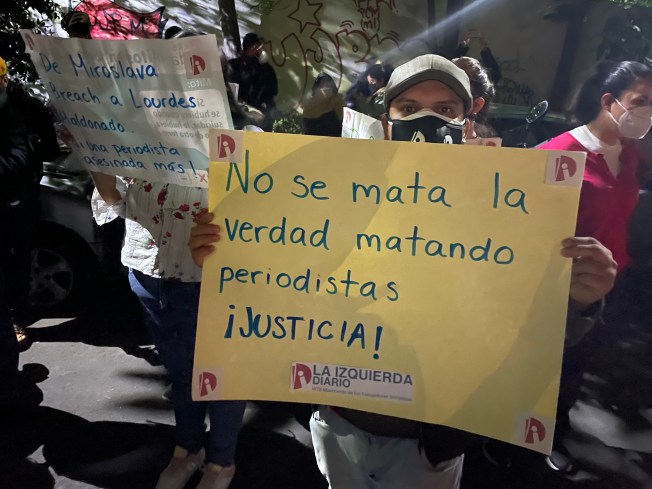After reporter Maria Guadalupe Lourdes Maldonado López was shot and killed in her car outside her Tijuana home on Sunday, January 23, journalists in Mexico put out a call to action in group chats and across social media platforms. It was time to protest.
Maldonado’s death was the third journalist killing in less than a month, after the stabbing death of reporter José Luis Gamboa Arenas in Veracruz on January 10 and the shooting of Tijuana photo journalist Alfonso Margarito Martínez Esquivel on January 17. A fourth journalist, Jaime Vargas, is hospitalized in the eastern Yucatán state after attackers broke into his home and stabbed him while he was asleep next to his wife, according to local news reports.
On Tuesday, journalists in almost 40 locations around the country – including in cities where protesting could draw the ire of organized crime groups – took to the streets to try to end the killings. They called for the Mexican government, which offers protection mechanisms for journalists at the federal and state levels, to do more to ensure security for reporters under threat. (Several reporters enrolled in such programs, including Maldonado, have been killed.)
CPJ attended a rally in Mexico City, where a crowd of several hundreds of journalists, human rights defenders, and others gathered in front of the Ministry of the Interior. They held up photos of killed reporters, lit candles, and projected the photos of slain colleagues on the wall of the massive building.
“I think this is a new awakening for Mexican journalists,” Maria Idalia Gómez, editor-in-chief of newspaper Eje Central told CPJ. “When Margarito was killed, we felt anger and frustration, but there wasn’t an immediate response. When Lourdes was killed, however, it was just too much.”
“It’s difficult to put into words what the killings have done,” Vicente Calderón, editor of news website Tijuana Press told CPJ by phone after attending the march in Tijuana. He knew both Martínez and Maldonado. “You would think that, as journalists who go out every day to cover crime and violence in this city, we would have built up some kind of immunity, but even though we have gotten used to [violence], it has still been a terrible week with lots of introspection.”
Calderón said that the protests, held in Tijuana at the Paseo de los Héroes, were an important way to address impunity. “It sometimes seems pointless, because we do this every so often and the violence continues, but it’s one necessary step. One of my first experiences as a journalist was protesting the murder of Héctor Félix Miranda in 1988. I believe that us protesting ultimately pressured the authorities into arresting several suspects.” (In 1991, two men were sentenced to 25 and 27 years in prison respectively for the murder.)
In Cancún, on Mexico’s southern Caribbean coast, a small group of journalists gathered in front of the municipal palace, the same spot where police used live ammunition to disperse a crowd on November 9, 2020, wounding at least two reporters. Alejandro Castro, a reporter for El Heraldo de México, Novedades Quintana Roo, Aristegui Notícias, and Agence France-Press, helped organized the protest. He carried a sign that read, “We don’t forget that this is where they shot at us.”
“I think this can be a watershed moment in the collective struggle for better, safer and dignified working conditions,” he told CPJ via messaging app. “The rallies were also spearheaded by young journalists, which to me signifies a generational change.”
“I don’t recall a moment like this, when journalists went out to protests so massively, not even in the days after the [2017] murders of Miroslava Breach and Javier Valdez,” Verónica Espinosa, the correspondent of news magazine Proceso in the central Mexican state of Guanajuato, where reporter Israel Vázquez was shot dead in November 2020 told CPJ. “This is a snowball, everything adds to it: the insecurity, the lack of justice. It’s a sign that nothing has changed, despite what the president, the authorities, have said.”
In Cuernavaca, just south of Mexico City, Estrella Pedroza, a freelancer who publishes in local and national media and one of the organizers of the local protest, told CPJ via messaging app that women journalists are at particular risk. “What is particularly scary to me is how they shot a female colleague, almost in front of her home,” she said of Maldonado. “If journalism is dangerous work, it’s doubly so for women. We face different kinds of violence, threats and intimidations than our male colleagues.”
“I would like to think that this is a historical event, that it’s a watershed moment, but I’m not sure that it will lead to fundamental changes,” she added. “But I think it’s still historical, in that more people came out to protest, more cities joined in, despite the pandemic.”





